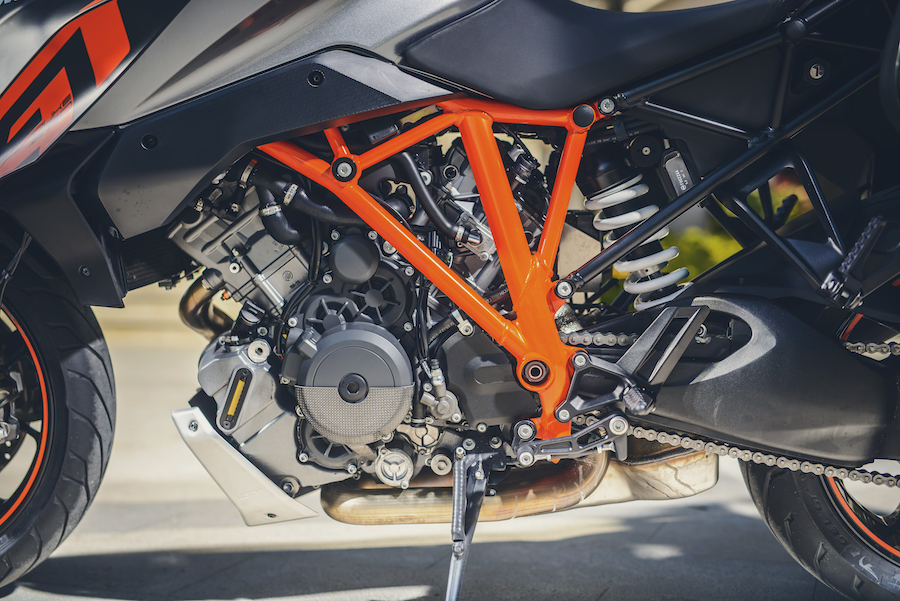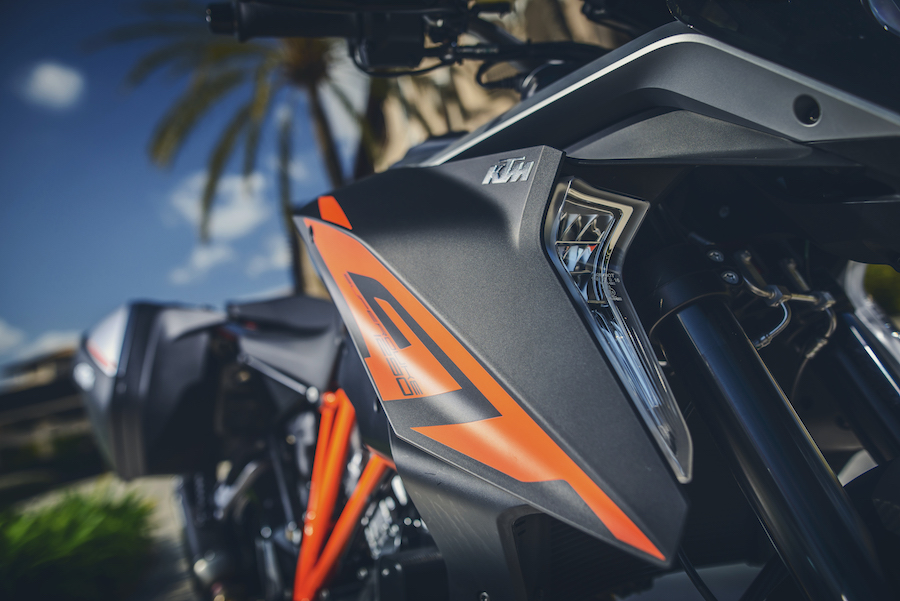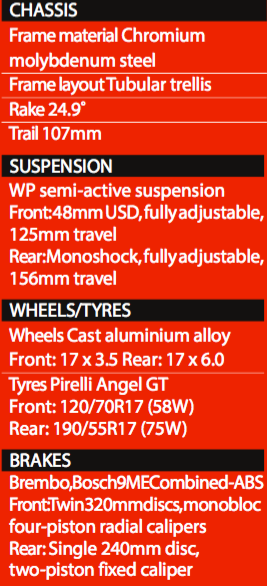Are you bored of sharp scenery? Yearning to make the bella-vista a blur? Even when they’re touring, KTM are ready to race.
How can a motorcycle be soft and approachable, but also sharp and brutal?
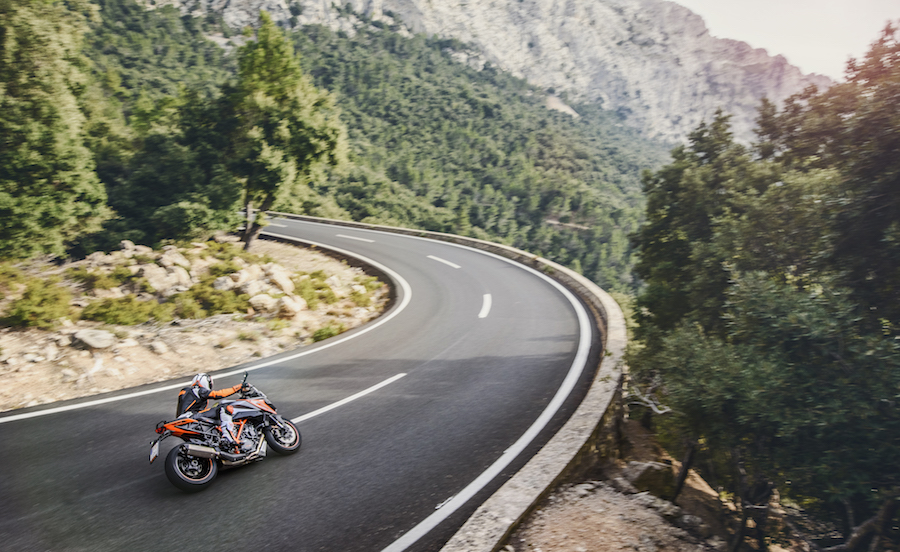
It depends on what you’re comparing it to, and also on the sophistication of its electronics. The 1290 Super Duke GT represents the softer side of a seriously hard edged motorcycle family, and it’s only the brilliance of its combined Keihin and Bosch brain power which make it so civilised. Because, make no mistake, the GT retains all the brute force of the Super Duke R from which it was derived, but somehow delivers it in a softly rounded package of useability. Like meticulously prepared lunacy, lovingly delivered in easy to chew lumps of grunty goodness. I can still taste it now.
The Mattighofen mob’s first true road-only tourer is still very much a Kiska designed KTM in the modern mould, and so has all the aggressive angularity, sharp edges, and Vegemite-effect looks which identify its styling as Austria’s finest. But in comparison to its naked non-identical twin the Super Duke R, there has been a subtle softening of the all-round ride experience for the GT. And this has been done miraculously and thankfully without blunting the Super Duke’s signature of savage performance which, as anyone who has ridden one knows, gloriously walks the line between silly and sublime. This element has remained on par with the R model in every way, with the exception of the unavoidable touring-weight gains of a bigger tank, increased wind protection, and beefed-up load-carrying rear end, plus of course the panniers if you are running them.

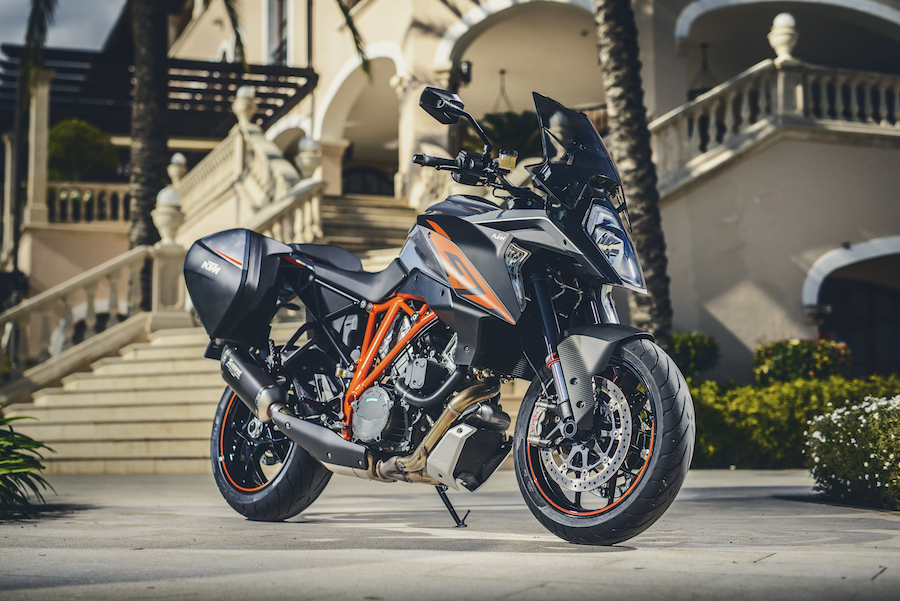
Everything possible has been done to minimise the increase in weight, and keep the power-to-weight ratio close to that of the Super Duke R. One such method involved making use of the fast pace of battery development. Even though the GT has an increased array of electronics, its battery is smaller and lighter than the one in the Super Duke R. The adjustable screen is something which could have added a lot more weight, too, but KTM has opted for brilliantly simple design which requires no heavy mechanisms to make it work. It is also one of the easiest screens to adjust on the move of any bike I’ve tested. There’s no knobs to wind it up and down or lock nuts to tighten once the screen is moved. You just push it out, pull it up or down to the desired position, and pull it back to locate it in place.
The GT’s 23 litre tank should get you a minimum distance of around 300km even at a hoonish rate of knots. If, however, you can manage to resist the throttle wrenching urges which the 1301cc V-Twin tends to arouse in even the meekest of Earthlings, and perhaps even take the ‘touring’ part of the GT moniker literally, it’s entirely possible the range may stretch much closer to the 400km which KTM claim is achievable. Although, I’m pretty sure you’d need to keep ‘Rain’ mode engaged and cruising speed to the legal limits to get anywhere near that distance. But it’s still a more than respectable range for this type of bike.
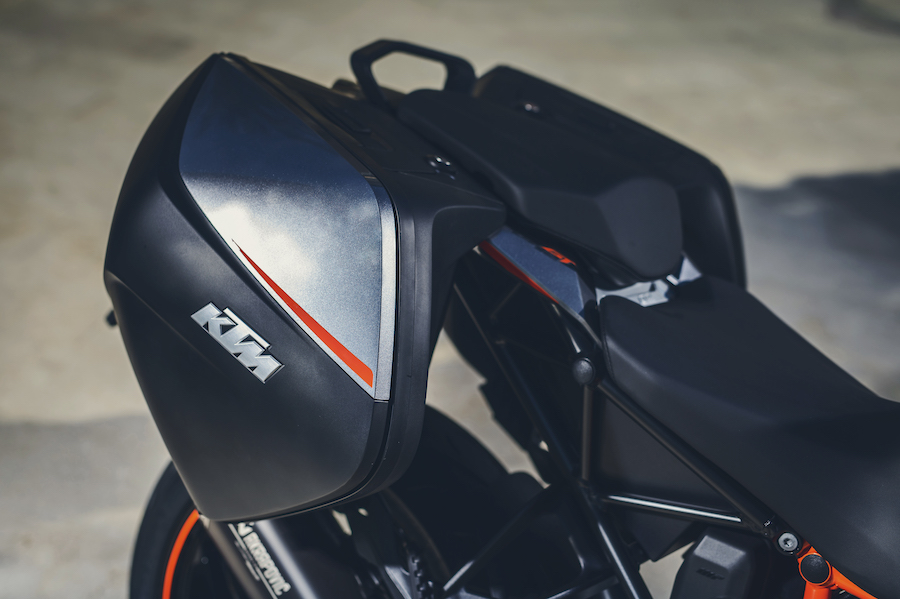
Jutting forward from the enlarged tank, the new sections of bodywork contain the intake ducts which feed the pressurised airbox, and also house the LED cornering lights. These were first featured on the 1290 Super Adventure, and use the bike’s Bosch IMU to gradually increase near-side lighting immediately adjacent to the front wheel. The three stages of illumination are triggered at 10, 20 and 30 degrees of bank angle. Although I never got to ride the GT after dark, I’ve tested the riding lights on the Super Adventure and they were a real benefit to night vision, adding breadth to the near beam and illuminating the corner verges to uncover any hobgoblins hiding in the long grass.
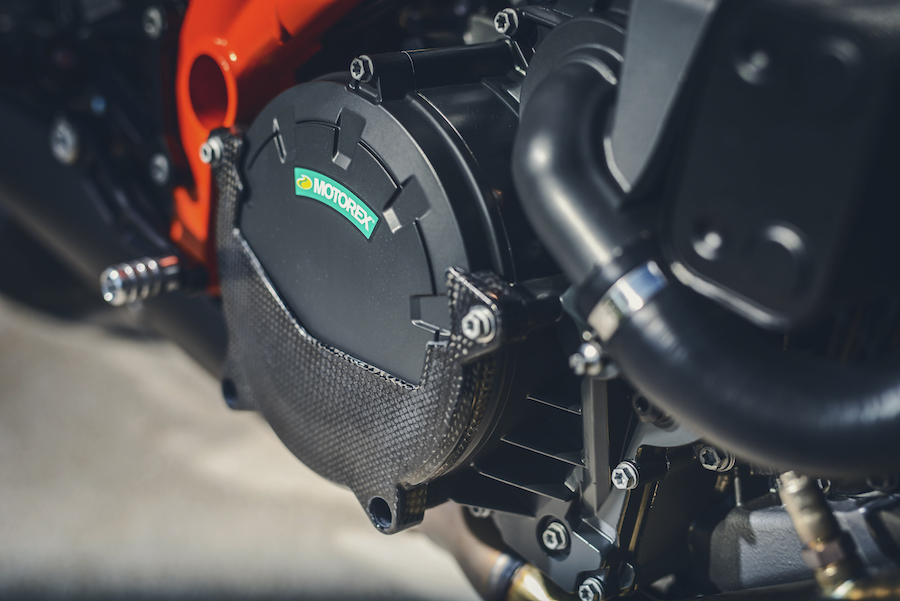
Adjustability is essential to be a premium player in the touring game these days, and rather than go with what everyone else is doing in the road bike world, KTM typically has taken some tricks from their world leading dirt bikes. The handlebar clamps are offset and reversible, with two alternative mounting positions on the top fork yoke, giving four possible positions and 22mm of adjustment. The bars themselves have a rather pleasing swept back profile which feels a lot more organic than the straighter ‘attack position’ bars on the Super Duke R. They play a big part in making the GT an all-day attraction.
The extremes of human foot sizes are accommodated for thoughtfully with three-way adjustable gear and rear brake levers. Differing digit lengths are also catered for, with fully span adjustable clutch and front brake levers. These features may seem minor, but for a premium bike I see them as essentials which aren’t always offered.
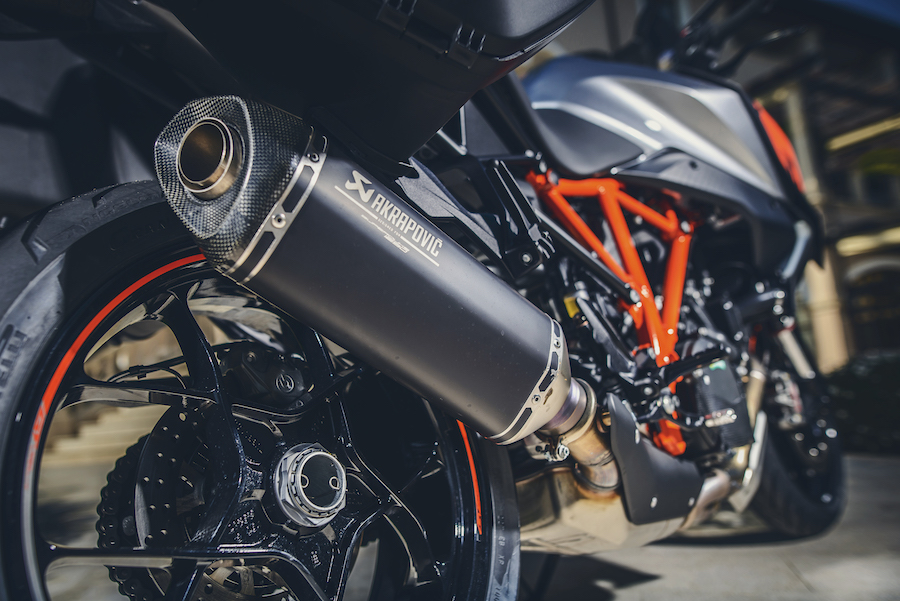
The seat is by far the most important contact point for a bike pitching to become your long distance travel buddy. It’s also the area where you and your new two-wheeled significant-other will either bond or grate. During the 300km island waltz which formed my get-to-know-you period with the GT, I believe we formed an intimacy of mutual satisfaction at a pants level (it was certainly good for me), and one I’m extremely keen to explore further in the future if the opportunity arises.
Architecturally, the GT’s seat is broad, long and very flat. It also seems quite firm initially, although this didn’t transfer into it feeling hard over distance. This design is quite a contrast to the heavily sculpted saddles which are the norm for tourers – having more in common with the sportsbike world – and makes performing the gymnastics of sports riding feel very much part of the GT’s natural repertoire. The wider tank and lower foot rests finish off the transformation from Super Duke R ergos to the Grand Touring version, and all the changes added to my feeling that the GT offers a far more natural riding position for riding both far and fast.

The Eurocrats of the European Parliament in Brussels don’t often get much praise, particularly in the motorcycle press, for the ever increasing regulations governing vehicle standards. But I reckon they’ve actually done us a big favour with the latest Euro 4 emissions tests. The glut of new bikes coming through with Euro 4 compliance have without exception been the better for it, felt in the refinement of their power delivery and general engine characteristics. And the 1290 GT is another glowing example of this.
What has happened, is the emissions engineers and engine designers have had to start working together to find solutions, rather than the emissions department just fixing up all the problems of an inefficient engine in the final stages of development. This may not entirely be the case for all manufacturers, but it is certainly the case for some.
Like most factories trying to adapt current engines to comply with Euro 4, KTM has taken a fresh look at their monstrously powerful 1301cc V-Twin and found big efficiency gains to be made, particularly in the cylinder head, and without any detriment to overall performance. Calibration strategies for ride-by-wire systems are also improving out of necessity to squeeze more performance from less fuel, therefore producing lower emissions of those nasty evil kitten-killing gases which are destroying our planet. A dual spark plug ignition with two separate ignition maps helps optimise the combustion process and saves the planet too, kind of.
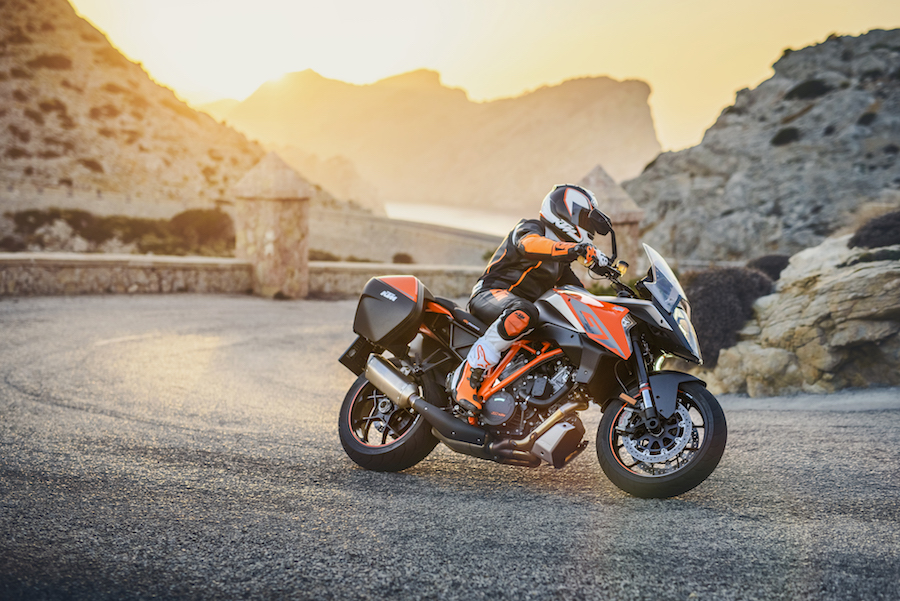
If there’s one criticism that can be lumped on the GT, it’s that the thumping great V-Twin becomes a little lumpy at engine speeds below 4500rpm. It’s not as if the wheels are going to fall off, but still, loading it with excess throttle at low rpm makes it obvious this engine was designed to work best in the very wide sweet spot – more like a sweet splat then – between 5000rpm and its redline of 10,500rpm. The truth is I hardly noticed this until I decided to deliberately provoke it with a fist-full of throttle at low speed in a high gear. The rest of the time I instinctively spun the GT’s engine to where it wanted to be, without a care of what the tacho was saying.
The fact that nobody in our group of 20 or so idiot journos crashed on the wet, polished and chalk dust covered mountain roads of the test route could be considered a miracle, that is, if it wasn’t so obviously down to the GT’s superb electronics keeping a motherly eye over the questionable antics of the international rabble of riders. In parts, these were some of the slickest roads I’ve ever ridden, with tight, steep and winding switchbacks to add to the dodge factor. Using front brake only on such a steep slippery road takes some mental fortitude, but the C-ABS system automatically feeds in just the right amount of rear brake to keep the bike balanced, while of course ensuring no wheel lockage occurs at either end.
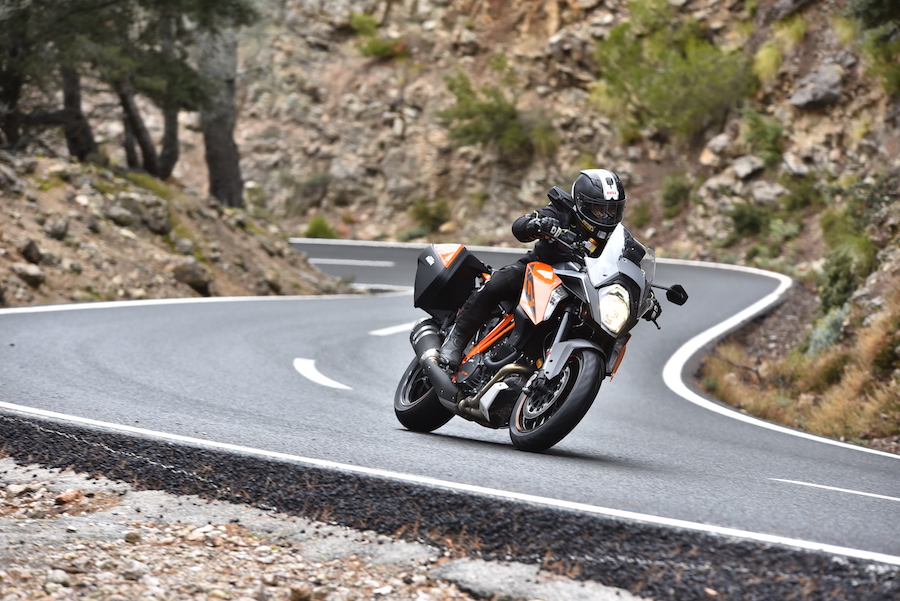
It’s the same story with the GT’s traction control system (MSC), which continues the same level of excellence found on both the Super Duke R and the Super Adventure models. What is different from the Super Duke R, though, is how much more civilised the GT behaves with the electronics turned off. It’s that softer throttle progression which makes even the full unbridled power in ‘Sport’ riding mode more manageable than the ‘Beast’, despite matching its power output. The reduction in power for ‘Rain’ is significant – ideal for dodgy conditions, or just cruising and conserving fuel. It’s still plenty fast, too.
So we know it’s fast, but a bike just ain’t ‘touring’ unless you can pack it with your own version of life’s essentials, and the GT comes ready to accept the genuine pannier set with a discreet set of mounts, blended neatly into to the standard tail section. Fitting the panniers requires a reassuringly firm push, which is greeted with an affirmative ‘click’, at which point you have no doubt your belongings are securely stowed. The panniers are not only supremely solid once mounted, they’re also uniform in shape and volume thanks to the low slung silencer, and both are capable of swallowing a full face helmet. Their scalloped leading edge adds to the pillion’s security by giving an accommodating calf-shaped nook to hook legs over, with substantial ergorotically shaped clench rails completing your pillion’s feeling of coveted comfort. The 1290 Super Duke R is like mechanical dynamite, but because of it’s tiny tail section, lighting the fuse is best kept as a solo experience. This orange fire cracker, however, is built for sharing. Although, a tight thigh-squeeze and firm hand-grasp at the rear is still highly recommended.
Super Duke R geometry has been replicated for the GT, and considering how damn well it works, I’m not surprised KTM has kept the chassis dimensions unchanged. What they have done is move the weight of the headlight and screen from the forks to the frame, so none of the GT’s added weight detracts from the Super Duke’s light and responsive steering.
Jeremy McWilliams was heavily involved with development of the Super Duke R, and was again asked to lend his considerable skills and experience to make sure the GT also lived up to KTM’s mantra of ‘Ready to Race’. For the final suspension set-up work, Jezza spent two days on the GT at Almeria, the same Spanish race circuit where the R model chassis settings were developed. The aim was to get the GT’s WP semi-active suspension in ‘Sport’ riding mode matching the on-track performance of the Super Duke R. The results are sensational.
Of course, not every day on tour is a scratching day, and eventually there’ll be a long straight highway to endure. For navigating these necessary doldrums, Comfort mode softens the mood and relaxes the ride, and the cruise control is there to alleviate the aches of inaction. The CC system on the GT has been refined since its debut on the Super Adventure, with manual speed trimming and automatic speed adjustment for undulating roads noticeably improved.
KTM say they aim to attract riders who, having matured into touring bike ownership only to become oh-so-bored, now yearn a step back towards sportsbike performance. And you really do have to pinch yourself sometimes to remember this is quite rightfully categorised as a tourer. As well as pure performance baffling your senses, the GT’s quickshifter, a first on a KTM, keeps you looking for places and excuses to open up the taps, feel the unlaboured rush as you pop pop pop through the sweet, short and snickerty six-speed gearbox it shares with the Super Duke R, and hear that raunchy 75° V-twin roar. If that doesn’t make you want to grab the garage keys, I don’t know what will.

